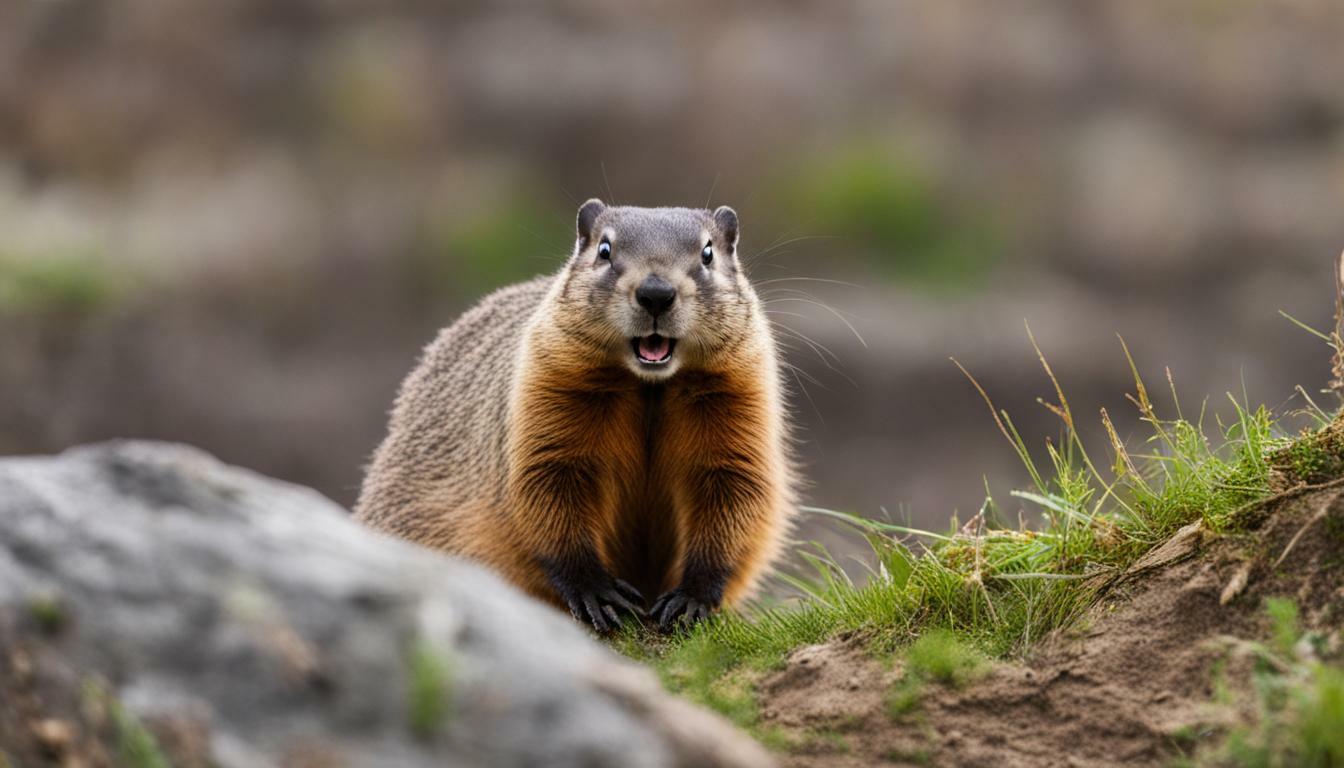Have you ever wondered if groundhogs make noise? Well, the answer is a resounding yes! Groundhogs, also known as woodchucks, are not just silent creatures hiding in their burrows. In fact, they have a wide range of vocalizations that they use for communication, defense, mating rituals, and more.
Key Takeaways:
- Groundhogs communicate through various vocalizations, including chirping, grunting, whistling, hissing, shrieking, growling, barking, and chattering.
- Their high-pitched whistle or scream can travel up to 500 yards, serving as a means of communication and warning to other groundhogs.
- Groundhogs also make clicking sounds, purring noises, and squeaks, especially baby groundhogs to communicate with their mothers and siblings.
- Communication among groundhogs extends underground, where they use vocalizations to maintain social connections, warn of danger, and navigate their intricate burrow systems.
- When feeling agitated or scared, groundhogs may exhibit growling, barking, and chattering sounds to ward off threats.
Groundhog Vocalizations: Exploring Their Sounds
Groundhogs are not just silent creatures – they have a wide range of vocalizations that serve different purposes. These charming rodents communicate through a fascinating repertoire of sounds. From chirping and grunting to hissing and growling, groundhogs use their vocal abilities to convey important messages to others in their community.
One of the most distinctive vocalizations of the groundhog is a high-pitched whistle or scream. This piercing sound can travel up to 500 yards, acting as an effective warning to other groundhogs of potential danger. It serves as a form of communication, alerting fellow groundhogs to be cautious and on the lookout.
In addition to their whistling calls, groundhogs also emit a variety of other noises. Clicking sounds and purring noises are lesser-known vocalizations that groundhogs use to express their emotions. These sounds can convey contentment or indicate possible territorial disputes between individuals.
Furthermore, baby groundhogs have their own unique vocalizations. They emit adorable squeaks, which are used to communicate with their mothers and siblings. These squeaks help the young groundhogs stay connected and navigate their environments.
| Vocalization | Purpose |
|---|---|
| Chirping | Communication |
| Whistling | Warning |
| Grunting | Defense |
| Hissing | Agitation |
| Shrieking | Alarm |
| Growling | Aggression |
| Barking | Intimidation |
| Chattering | Alert |
Groundhog vocalizations play an important role in their daily lives. Whether it’s warning others of danger, expressing emotions, or communicating with their young, the sounds these creatures make contribute to their overall social dynamics. So, next time you see a groundhog, pay attention to the various noises they produce – you might be surprised by their vocal prowess!
The High-Pitched Whistle of Groundhogs
When it comes to expressing themselves, groundhogs have a unique high-pitched whistle that can be heard from quite a distance. This distinctive sound serves as a means of communication and warning to other groundhogs in the wild. But how far can this whistle actually travel? Groundhog vocalizations have been recorded to carry for up to 500 yards, allowing them to communicate effectively across their habitat.
But why do groundhogs use this high-pitched whistle? One of the main purposes is to alert other groundhogs of potential danger. When they feel threatened or sense an approaching predator, groundhogs emit this loud whistle as a way of warning their fellow burrow mates. This helps to ensure the safety and well-being of the entire groundhog community.
To give you a better idea of groundhog vocalizations in the wild, let’s take a closer look at the fascinating sounds made by these creatures. Here’s a table summarizing the different noises groundhogs are known to produce:
| Vocalization Type | Description |
|---|---|
| Chirping | A series of short, high-pitched sounds |
| Grunting | A low, guttural noise used for communication |
| Whistling | A distinctive high-pitched whistle that can travel up to 500 yards |
| Hissing | A sharp, hissing sound when feeling threatened |
| Shrieking | A loud, piercing scream when in distress |
| Growling | A deep, menacing sound used for defense |
| Barking | A sharp, repetitive sound as a warning to others |
| Chattering | A rapid, chattering noise when agitated or scared |
As you can see, groundhogs have a diverse vocal repertoire beyond their well-known whistle. These sounds serve various purposes, including communication, defense, warning, and mating rituals. The ability to produce such a range of noises showcases the vocal nature of groundhogs and their importance in the animal kingdom. So, the next time you hear a high-pitched whistle in the wild, you might just be listening to the unique call of a groundhog.
Remember, groundhogs are fascinating creatures that rely on vocalizations to navigate their burrows, communicate with their peers, and ensure their survival. By understanding their sounds, we can gain a deeper appreciation for these remarkable animals and the rich tapestry of communication that exists within the animal world.
Clicks and Purrs: Lesser-Known Groundhog Sounds
Besides their famous whistle, groundhogs also produce clicks and purrs, adding complexity to their vocalizations. These lesser-known sounds are another fascinating aspect of their communication repertoire.
Clicks are short, sharp sounds that groundhogs use to convey different messages. They can range from a soft click to a louder, more pronounced click. Groundhogs often produce clicks when they are feeling threatened or agitated. It’s their way of warning others and asserting dominance in their territory.
On the other hand, purrs are gentle, vibrating sounds that groundhogs make when they are content and relaxed. These soft, rhythmic purrs are usually emitted during social interactions or when groundhogs are enjoying their surroundings.
| Groundhog Sound | Meaning/Behavior |
|---|---|
| Clicks | Warning or asserting dominance |
| Purrs | Contentment and relaxation |
These additional groundhog sounds highlight the intricate and nuanced nature of their vocalizations. Whether it’s a click to establish boundaries or a purr to express satisfaction, groundhogs have a diverse range of sounds that help them navigate their social and environmental surroundings.
Baby Groundhogs and Their Squeaks
Baby groundhogs have their own unique vocalizations, including adorable squeaks that help them communicate with their family. These tiny squeaks serve as a way for baby groundhogs to express their needs, emotions, and even establish bonds with their mother and siblings. Similar to human babies, these squeaks are often a sign of excitement, hunger, or distress.
As baby groundhogs grow and explore their surroundings, their vocalizations become an integral part of their social interactions. Through squeaking, they can signal their presence to their family members, locate each other when separated, and even indicate their desire to play or receive attention. It’s fascinating to observe how these little creatures use their adorable sounds to establish connections within their close-knit family units.
Table: Baby Groundhog Vocalizations and Their Meanings
| Vocalization | Meaning |
|---|---|
| Squeaks | Expressing needs, emotions, and establishing bonds |
| High-pitched chirping | Signaling excitement or happiness |
| Whimpering | Indicating distress or discomfort |
| Soft purring | Expressing contentment or relaxation |
These adorable vocalizations play a crucial role in the growth and development of baby groundhogs. As they continue to mature, they will gradually adopt the diverse vocal repertoire of adult groundhogs, allowing them to communicate effectively with their family and navigate the world around them.
Groundhog Communication Underground
Underground, groundhogs rely on vocalizations to stay connected and communicate with other members of their colony. These vocalizations serve various purposes, including maintaining social connections, warning of danger, and navigating their intricate burrow systems.
One of the primary reasons groundhogs communicate underground is to maintain social bonds within their colony. They use different vocalizations to establish and reinforce their relationships with other groundhogs. By emitting specific sounds, they can relay information about their identity, status, and intentions, which helps establish a sense of hierarchy and cooperation within the group.
Furthermore, vocalizations play a crucial role in warning others about potential threats or dangers. When groundhogs detect an approaching predator or intruder, they emit loud and distinct sounds to alert their fellow colony members. This warning system helps protect the entire group from potential harm and allows them to quickly retreat to the safety of their burrows.
| Vocalization | Purpose |
|---|---|
| Chirping | Communication within the group |
| Whistling | Warning of danger |
| Grunting | Expressing dominance or submission |
| Hissing | Intimidation and defense |
Additionally, groundhogs use vocalizations to navigate their burrows effectively. Their burrow systems can be complex and maze-like, with multiple entrances and chambers. By emitting specific sounds, groundhogs can communicate their location and direction to others within the colony. This communication helps coordinate activities, find food sources, and avoid accidental encounters or conflicts underground.
In conclusion, groundhogs are highly vocal animals, relying on a range of vocalizations to communicate effectively underground. Through these sounds, they establish social connections, warn of danger, and navigate their burrow systems. Vocalizations are an essential part of their communication repertoire and play a vital role in their survival and group dynamics.
Groundhog Noises and Behaviors: Agitated or Scared
When groundhogs are agitated or scared, they display specific noises and behaviors, such as growling, barking, and chattering. These vocalizations serve as a warning to potential threats and communicate the groundhog’s unease or fear. Groundhogs are not typically aggressive animals, but when they feel threatened, they may exhibit defensive behaviors to protect themselves or their territory.
Table 1: Groundhog Noises and Behaviors
| Noises | Behaviors |
|---|---|
| Growling | Groundhogs emit a low, rumbling sound similar to a deep growl. This noise is often accompanied by showing their teeth and aggressive posturing. |
| Barking | When feeling threatened, groundhogs may bark loudly, resembling a dog’s bark. This noise is meant to intimidate potential predators or intruders. |
| Chattering | Groundhogs make a series of rapid, high-pitched clicking sounds, known as chattering, when they are agitated. This behavior is often observed when they sense danger nearby. |
These sounds and behaviors are part of the groundhog’s defense mechanism and are used to deter predators or other groundhogs from encroaching on their territory. While they may seem intimidating, it’s important to remember that groundhogs are generally shy and prefer to retreat to their burrows to avoid confrontation whenever possible. Understanding their vocal cues and behaviors can help humans coexist peacefully with these fascinating creatures.
Groundhog Vocalizations and Mating Rituals
Groundhog vocalizations play a vital role in their mating rituals, helping male groundhogs attract females and establish their dominance. These vocalizations can range from chirping and grunting to hissing and growling, each serving as a unique form of communication.
During mating season, male groundhogs use specific sounds to express their interest in potential mates. The combination of grunts, barks, and whistles creates a melodic symphony aimed at capturing the attention of receptive females. These vocal displays not only showcase the male’s physical abilities but also act as a means of asserting dominance over rival males.
To enhance their chances of mating success, male groundhogs often engage in physical battles, fighting for the attention of a female. These fights are accompanied by intensified vocalizations, including aggressive growls and piercing shrieks. The winner of such encounters gains the opportunity to mate with the female, while the defeated males may retreat and try their luck elsewhere.
Table: Groundhog Vocalizations during Mating Rituals
| Vocalization | Meaning |
|---|---|
| Chirping | Expressing interest and excitement |
| Grunting | Asserting dominance and showcasing physical abilities |
| Barking | Attracting the attention of receptive females |
| Whistling | Communicating readiness for mating |
| Growling and shrieking | Engaging in physical battles for dominance |
In conclusion, groundhog vocalizations are not only a fascinating aspect of their behavior but also serve a crucial purpose in their mating rituals. By using a variety of sounds, male groundhogs can attract females, assert their dominance, and increase their chances of successful reproduction. The intricate combination of vocalizations and physical displays truly showcases the communication skills and competitive nature of these remarkable creatures.
Conclusion
Groundhogs are undoubtedly not the silent creatures we might expect – their diverse range of sounds adds to their fascinating nature. These furry rodents possess a surprisingly vast vocal repertoire, using various vocalizations to communicate, defend, warn, and mate. From chirping and grunting to whistling and hissing, groundhogs utilize an array of sounds to convey messages to their fellow groundhogs.
One standout vocalization is the groundhog’s high-pitched whistle or scream, which can travel impressive distances of up to 500 yards. This piercing sound serves as a vital means of communication and acts as a warning to other groundhogs. Beyond the whistle, groundhogs also produce lesser-known sounds like clicking and purring, adding depth to their vocal expressions.
Even baby groundhogs have their own unique squeaks, using these vocalizations to communicate with their mothers and siblings. Additionally, when engaged in territorial disputes, these young groundhogs may emit snapping noises as they fight for their space.
Groundhogs also communicate underground through their vocalizations, using sounds to maintain social connections, navigate their intricate burrows, and alert others to potential dangers. Moreover, when feeling agitated or scared, groundhogs may resort to growling, barking, or chattering sounds as a display of their discomfort or fear.
In the realm of romance, groundhogs employ their vocalizations to attract mates and establish dominance during mating rituals. Their distinct sounds create an auditory landscape that plays a crucial role in their social interactions.
In conclusion, groundhogs possess a wide range of sounds that contribute to their expressive and captivating nature. From their striking high-pitched whistle to the clicks, purrs, and squeaks they produce, these vocalizations serve important purposes in their daily lives. So, the next time you come across a groundhog, remember to appreciate not only their adorable appearance but also the symphony of sounds they bring to the animal kingdom.
FAQ
Do groundhogs make noise?
Yes, groundhogs do make noise. They communicate through various vocalizations such as chirping, grunting, whistling, hissing, shrieking, growling, barking, and chattering.
What are the purposes of groundhog vocalizations?
Groundhogs use vocalizations to defend themselves, warn other groundhogs of danger, communicate underground, during mating rituals, and when they are agitated or scared.
What is the high-pitched whistle of groundhogs?
The high-pitched whistle or scream is a distinctive sound that groundhogs emit, which can travel up to 500 yards. It serves as a means of communication and warning to other groundhogs.
Are there lesser-known sounds made by groundhogs?
Yes, groundhogs also make clicking sounds and purring noises, showcasing their diverse vocal repertoire beyond their well-known whistle.
Do baby groundhogs make sounds?
Yes, baby groundhogs emit squeaking sounds. These vocalizations are used for communication with their mothers and siblings.
How do groundhogs communicate underground?
Groundhogs communicate underground through vocalizations. These sounds are used to maintain social connections, warn of danger, and navigate their burrows.
What sounds and behaviors do groundhogs exhibit when agitated or scared?
When groundhogs are agitated or scared, they may growl, bark, or make chattering sounds.
How do groundhog vocalizations play a role in mating rituals?
Groundhogs use specific sounds during mating rituals to attract females and establish dominance.
What have we learned about groundhog vocalizations?
Groundhogs are highly vocal creatures that use different sounds for various purposes. Their vocalizations include chirping, grunting, whistling, hissing, shrieking, growling, barking, chattering, and more.




